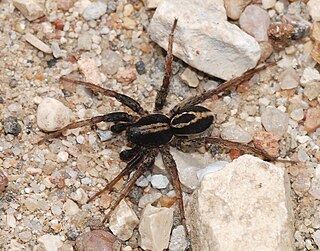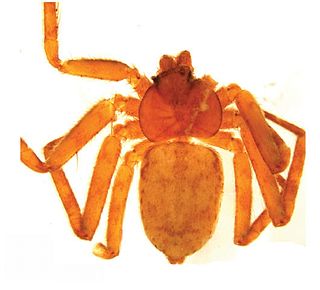
The Pholcidae are a family of araneomorph spiders. The family contains over 1,800 pholcids, including those commonly known as the marbled cellar spider , daddy long-legs spider, granddaddy long-legs spider, carpenter spider, daddy long-legger, vibrating spider, gyrating spider, long daddy, and skull spider. The family, first described by Carl Ludwig Koch in 1850, is divided into 94 genera.

Selenopidae, also called wall crab spiders, wall spiders and flatties, is a family of araneomorph spiders first described by Eugène Simon in 1897. It contains over 280 species in nine genera, of which Selenops is the most well-known. This family is just one of several families whose English name includes the phrase "crab spider".

Periegops is a genus of spiders with six eyes instead of the usual eight. It is the only genus in its family (Periegopidae) and has three described species. It was long considered to be members of Sicariidae or Segestriidae until Raymond Forster elevated them to the family level in 1995.

Selenops is a spider genus that is found in many deserts of the world. It is very hard to distinguish the 115 species.

Selenops radiatus is a species of flatty in the spider family Selenopidae. It is found in Mediterranean, Africa, the Middle East, India, Myanmar, and China.
Paleontology or palaeontology is the study of prehistoric life forms on Earth through the examination of plant and animal fossils. This includes the study of body fossils, tracks (ichnites), burrows, cast-off parts, fossilised feces (coprolites), palynomorphs and chemical residues. Because humans have encountered fossils for millennia, paleontology has a long history both before and after becoming formalized as a science. This article records significant discoveries and events related to paleontology that occurred or were published in the year 1984.
Garcorops jadis is a possibly extinct species of Wall crab spider, family Selenopidae, and at present, it is one of four known species in the genus Garcorops. The species is solely known from copal found on the beach near Sambava, on the northeast coast of Madagascar.
Selenops rosario is a species of spider from the family Selenopidae. The scientific name of this species was first published in 2005 by G. G. Alayón. Its native habitat is in Cuba.

The RTA clade is a clade of araneomorph spiders, united by the possession of a retrolateral tibial apophysis – a backward-facing projection on the tibia of the male pedipalp. The clade contains over 21,000 species, almost half the current total of about 46,000 known species of spider. Most of the members of the clade are wanderers and do not build webs. Despite making up approximately half of all modern spider diversity, there are no unambiguous records of the group from the Mesozoic and molecular clock evidence suggests that the group began to diversify during the Late Cretaceous.

Alireza Zamani is an Iranian arachnologist and taxonomist.

Amamanganops is a monotypic genus of Filipino wall spiders containing the single species, Amamanganops baginawa. It was first described by S. C. Crews & Mark Stephen Harvey in 2011, and is found in the Philippines.
Godumops is a monotypic genus of Papuan wall spiders containing the single species, Godumops caritus. It was first described by S. C. Crews & Mark Stephen Harvey in 2011, and is found in Papua New Guinea.
Hovops is a genus of Malagasy wall spiders that was first described by P. L. G. Benoit in 1968.
Makdiops is a genus of Asian wall spiders that was first described by S. C. Crews & Mark Stephen Harvey in 2011.

Siamspinops is a genus of Asian wall spiders that was first described by P. Dankittipakul & J. A. Corronca in 2009. It was merged with the monotypic genus Pakawops in 2019.

Castianeira longipalpa is a species of true spider in the family Corinnidae. It is found in the United States as well as Canada. It is a type of ant-mimic sac spider, and has most often been observed along the east coast of North America.
Selenops lobatse is a species of araneomorphae spider in the family Selenopidae.

Selenops insularis is a species of flatty in the spider family Selenopidae. It is found in the United States and Greater Antilles.











